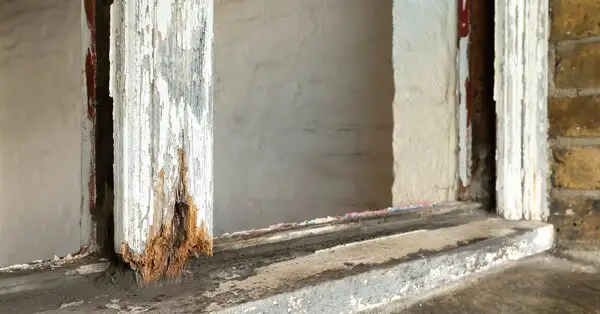The Problem
Like termite damage, wood rot can spread rapidly. Moisture penetrates your timber via cracks, holes, and gaps, often in plain sight. With a minimum moisture content of 20%, combined with the right temperature and oxygen levels, fungal growth takes place at the core of the structure. Decaying timber is a natural process in the forest; however, it’s not something that you want occurring at your home.
How Our Team Can Help
When you hire our expert wood rot repair team, you can expect their meticulous attention to detail to bring you the results you need. First, they’ll provide a detailed diagnosis by detecting the type of fungal growth you’re dealing with. It could either be dry rot or wet rot, which vary in their wood rot treatment. Dallas property owners should know that when left long enough, wood rot can destroy anything in its wake. Because the structure of your home is largely dependent on its wooden framework, repairing or removing damaged wood is crucial for maintaining safety and integrity.
Assessment
Once we have a diagnosis, whether wet or dry rot repair is required, there is a preparatory step, which involves removing all the damage to the wood before it can spread further. Also, if the material is soaking wet, it must dry first because we can determine how patching and replacing is needed. This drying phase is crucial in ensuring that the new material adheres strongly and that the integrity of the structure can be maintained. Once the affected area has dried effectively, our local professionals will assess the extent of the necessary repairs and proceed with the restoration process.
Our Solution
Depending on the level of damage, it is often more cost-effective to replace the wood rather than use epoxy resin. What's more, replacement ensures that the integrity of the structure is restored completely. The reason is that there is a two-phase process with epoxy repairs, starting with liquid epoxy, followed by moldable, sculpwood putty (or kneadable epoxy) to fill the missing wood areas. Afterward, it needs time to dry before it’s sanded down and stained. If you need a hand with the painting or staining process after we have sanded the structure, we are more than willing to assist in that process as well. Staining and painting your wooden structures regularly is key if you want to prevent wood rot from forming again in the future.
Types of Wood Rot We Fix
There are two types of wood rot that we may have to tend to during wood rot repair. Dallas handyman experts on our team are well-versed in wet and dry rot repair, so you can rest assured that regardless of the fungus causing deterioration on your structure, we have a solution for you. Let's take a look:
Dry Rot Repair: Dallas
The name "dry rot" is quite paradoxical because this type of wood rot develops not from dryness, but when the moisture content in the wood exceeds 20%. This is the brown variant—a member of the brown-rot fungi. It is known to be the most destructive and fastest-growing type. It consumes and breaks down the timber’s cellulose from the core, so the whole structure appears to be shrinking. The most dangerous area to have dry rot is in your attic, where attic joists provide structural integrity to your house. Outdoor areas include your crawl space, decking, and fencing system.
Though it may be difficult to determine if it's time for dry rot repair, Dallas homeowners are recommended to keep an eye out for these common warning signs:
- Surface cracks or holes
- Velvety texture
- Discoloration, faded colors
- Shrinking timber
- Musty smells
- Brittle and crumbling
- Cubical fracture
Dry rot is not something to overlook. It has the ability to compromise the entire structure of your home, especially if it devours load-bearing elements. During dry rot repair, Dallas handyman experts will look for any sources of moisture. The moist or damp areas need to be addressed promptly; otherwise, you risk the same damage from occurring in the future.
Wet Rot
Other types of wood-eating fungi include wet or soft rot, which, unlike the brown variant, grows slightly slower. Rather than aggressively attacking the timber’s lignin or cellulose, it gradually weakens it. In this case, using boric acid (as a type of fungicide) often works wonders. Typically, wet rot develops in areas of your home where there is poor ventilation. You will often find it in door frames, window sills, your crawl space, and attic, because these areas are always in contact with water.
Telltale signs of soft rot include:
- Dark brown stains
- Discolored, damp surface
- Damp smells
- Softened texture
To treat wet rot, our handyman professionals will identify where the source of moisture is coming from, and address any leaks or water intrusion. From there, once the area has completely dried out, we will remove the damaged wood and apply a fungicide to prevent further growth.
Why Choose Mr. Handyman for Wood Rot Treatment, Dallas Homeowners?
Your highly trained and experienced handyman team at Mr. Handyman of Dallas brings years of experience to the industry, providing excellent workmanship and a commitment to customer satisfaction. As local business owners in the area, we have a strong dedication to earning your complete customer satisfaction. Because, at the end of the day, it's your home, and you have to be completely satisfied with its look and its feel. That's why you can expect our service professionals to go the extra mile during your wood rot repair. Dallas experts don't leave any stone unturned, ensuring a long-lasting result. We understand that when you need to repair wood rot, you want it done in a timely fashion. That's why we prioritize efficient services without sacrificing quality. Our local customers have referred to us as their one-stop shop for all their home improvement needs. From tile repair to fence installation and custom carpentry service, our Dallas handyman service professionals have you covered. To see why we're the top choice and qualified pick for wood rot repair, Dallas homeowners can read through our local reviews!
FAQs About Wood Rot Repair: Dallas
What Is The Best Way To Stop Rotted Wood From Spreading?
The sooner you detect it, the better the fungicide will be able to stop the spread. There are also rotted wood restorers or dry rot treatment fluids that you can use. But often, the most effective solution is to replace the affected piece of wood with a pre-treated one. We use high-quality materials that ensure long-lasting durability and longevity, minimizing the risk of future infestations. You will also want to ensure that in high-moisture areas, you do your best to maintain proper ventilation and keep the humidity levels in check.
How Do You Fill Large Holes in Rotted Timber?
Depending on the number of holes and the overall extent of the damage, you may be able to fix it with epoxy fillers. Often, combining epoxy with sawdust creates a strong paste that can be used during your wood rot repair in Dallas by simply filling the affected areas. This mixture not only helps restore the structural integrity of the wood, but once sanded down, it will allow for a smoother finish.
Can You Apply Epoxy Directly to Rotted Lumber?
It may sound easy, but it isn’t. In many cases, the wood rot repair process requires a drying time. Also, the rot must be removed first before you apply any consolidants, followed by a filler. We understand that it can be difficult to determine the type of rotten wood you have, making it difficult to handle the process for wood rot repair. Dallas homeowners, in these cases, are always encouraged to hire our team for help, who are well-versed in the different types of wood rot and their respective treatments.
Which Are The Most Common Places That Need Wood Rot Repair?
Dallas property owners will be surprised to find out how many wooden structures they have on their property for building materials. The most common places to inspect periodically include:
- Attic: joists, beams
- Crawl space
- Trims: fascia boards, corner boards
- Sheathing beneath the house siding
- Decking boards
- Fence
- Roof
- Window sills, window frames
- Door frames
- Baseboards
Because so many aspects of your home are made up of wood, it's important to regularly inspect these structures to keep an eye out for wood rot. Some structures, such as your fascia, are high up, which can be tricky to get to if you are not comfortable at high heights. That's why you can ask our handyman team to inspect these structures for you. It kills two birds with one stone, too, since if they notice any repairs that should be done, they will be able to tend to them.
Why Should I Hire a Professional for Wood Rot Repair in Dallas?
When it comes to wood rot repair, Dallas homeowners may not exactly know where to begin, or have access to the proper tools required. It's always best to leave this type of job to a professional. We will be able to accurately identify and diagnose the type of rot and ensure that all affected pieces are removed. We ensure a comprehensive approach to wood rot repair services, whereas a DIY attempt may only scratch the surface.
Do You Need Wood Rot Repair? Dallas Homeowners Will Find the Best Help at Mr. Handyman
Don't let wood rot linger for too long—otherwise, you'll pay the deadly consequences. Instead, get in touch with Mr. Handyman of Dallas, who offers high-quality workmanship and results that speak for themselves. If it's time to schedule an appointment for wood rot repair, Dallas homeowners can contact our exceptional customer service team today. We can help you deal with your rotted structures, whether you're located in Farmers Branch, Garland, or Rose Hill.
 Click to call
Click to call
 Click to call
Click to call


